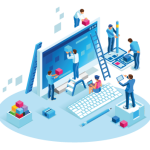The software development paradigm helps developer to select a strategy to develop the software. A software development paradigm has its own set of tools, methods and procedures, which are expressed clearly and defines software development life cycle. A few of software development paradigms or process models are defined as follows:
Waterfall Model
Waterfall model is the simplest model of software development paradigm. It says the all the phases of SDLC will function one after another in linear manner. That is, when the first phase is finished then only the second phase will start and so on.

This model assumes that everything is carried out and taken place perfectly as planned in the previous stage and there is no need to think about the past issues that may arise in the next phase. This model does not work smoothly if there are some issues left at the previous step. The sequential nature of model does not allow us go back and undo or redo our actions.
This model is best suited when developers already have designed and developed similar software in the past and are aware of all its domains.
Iterative Model
This model leads the software development process in iterations. It projects the process of development in cyclic manner repeating every step after every cycle of SDLC process.

The software is first developed on very small scale and all the steps are followed which are taken into consideration. Then, on every next iteration, more features and modules are designed, coded, tested and added to the software. Every cycle produces a software, which is complete in itself and has more features and capabilities than that of the previous one.
After each iteration, the management team can do work on risk management and prepare for the next iteration. Because a cycle includes small portion of whole software process, it is easier to manage the development process but it consumes more resources.
Spiral Model
Spiral model is a combination of both, iterative model and one of the SDLC model. It can be seen as if you choose one SDLC model and combine it with cyclic process (iterative model).

This model considers risk, which often goes un-noticed by most other models. The model starts with determining objectives and constraints of the software at the start of one iteration. Next phase is of prototyping the software. This includes risk analysis. Then one standard SDLC model is used to build the software. In the fourth phase of the plan of next iteration is prepared.
V – model
The major drawback of waterfall model is we move to the next stage only when the previous one is finished and there was no chance to go back if something is found wrong in later stages. V-Model provides means of testing of software at each stage in reverse manner.

At every stage, test plans and test cases are created to verify and validate the product according to the requirement of that stage. For example, in requirement gathering stage the test team prepares all the test cases in correspondence to the requirements. Later, when the product is developed and is ready for testing, test cases of this stage verify the software against its validity towards requirements at this stage.
This makes both verification and validation go in parallel. This model is also known as verification and validation model.
Big Bang Model
This model is the simplest model in its form. It requires little planning, lots of programming and lots of funds. This model is conceptualized around the big bang of universe. As scientists say that after big bang lots of galaxies, planets and stars evolved just as an event. Likewise, if we put together lots of programming and funds, you may achieve the best software product.

For this model, very small amount of planning is required. It does not follow any process, or at times the customer is not sure about the requirements and future needs. So the input requirements are arbitrary.
This model is not suitable for large software projects but good one for learning and experimenting.



Comments are closed